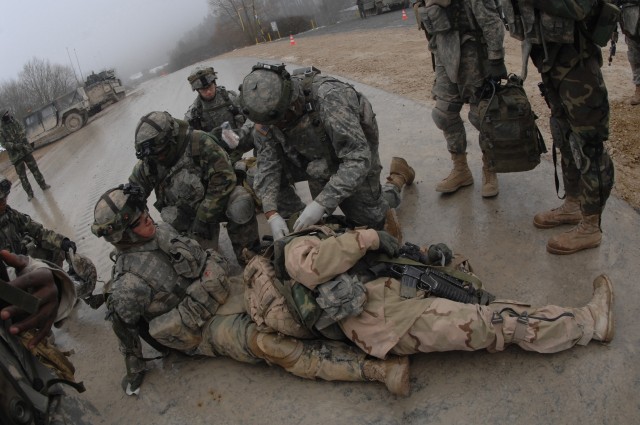
HOHENFELS TRAINING AREA, Germany (Dec. 12, 2007) -- 1st Lt. Robert Dansen peered into the twilight distance, the chill air slowly sapping the heat from his body as he waited for the next convoy to approach. It had been about two hours since Dansen's squad established a position in the hills just off one of the major routes 1st Armored Division had been using for its convoys.
The squad got its chance within 10 minutes, when a lengthy convoy drew near, led by a Mine Resistant Ambush Protected vehicle to guard the column from improvised explosive devices. Dansen and his squad of "insurgents" were prepared; two of his troops raised rocket-propelled grenade launchers as the line of vehicles approached.
As the MRAP passed a simulated IED, Staff Sgt. James P. Rondell, another "enemy" role-player from U.S. Army Europe's 1st Battalion, 4th Infantry, set it off. It did little to deter the MRAP, but the bad guys' coordinated RPG attacks destroyed the rear axle of the behemoth.
There were no "kills," but the mission was chalked up as more than a success, since a small group of five "insurgents" successfully took out the MRAP. If this had been a real battle, the loss of the vehicle may well have halted some of the division's planned operations. Instead it was a training drill, part of a Mission Rehearsal Exercise to prepare the division's 2nd Brigade Combat Team for a pending deployment to Iraq. The exercise has been ongoing here and at nearby Grafenwoehr Training Area since last month, and is scheduled to end Dec. 18.
The MRE is a standard preparatory tool for deploying units, and is built on scenarios tailored to provide realistic training that will equip Soldiers for their specific missions when they deploy for combat.
One example of the flexibility of the training is its ability to focus on various combat themes, from violent intense gun battles to the hit-and-run harassment techniques of small insurgent groups, said Dansen.
The Soldiers of the 1-4th who role-play as the "enemy" are the core of every MRE here. The unit's job is to make training as realistic and difficult as possible for Soldiers taking part in the MRE by using every enemy trick in the book, such as ambushes and kidnappings. The battalion's Soldiers deploy routinely to Iraq and Afghanistan to learn the real enemies' most up-to-date tactics, said Dansen.
"It's a lot of fun," the lieutenant admitted, grinning.
It may be fun, but more importantly -- it's realistic.
This MRE is incredibly useful in getting troops to understand what their commanders plan to do during deployment, said Maj. Kurt Thompson, operations officer for the brigade's 1st Battalion, 6th Infantry. "We've learned a lot, stuff that will keep us moving smoothly while 'downrange,'" he added.
Even something as routine as conducting meetings is part of the exercise, and takes planning and proper execution.
"Going to a meeting in garrison is a simple thing, but when you have to plan around going 'outside the wire' (leaving the relative safety of the garrison area) and the security that is involved with that, as well as the distance from (a unit's) Combat Observation Post to (its) Forward Operating Base, a simple meeting turns out to be a complicated move," said Thompson.
One solution, Thompson said, would be arranging to meet by video teleconference, to simplify and speed up the meeting process and keep Soldiers off of potentially dangerous roads where insurgents and IEDs lurk.
Capt. Erik C. Oksenvaag, commander of Company C, 1-6th, had a different communication problem to work out -- how to best use the lone interpreter assigned to his company. With three squads, each on its own rotating guard and patrol schedule, at least two squads were on patrol each day. It's no problem if the patrols do not pass through the nearby "Iraqi town," but part of the company's job is to maintain good relations with the locals, and that means going into town to meet with its council members, police officials and mayor -- a difficult task when the parties don't speak the same language and the unit has only one interpreter.
"It's not a large problem, but it is one more thing to account for when planning missions," Oksenvaag said.
As the MRE evolved, the exercise leaders and observer/controllers who watch every step of the action added subtle variations to each scenario. Their goal was to press the Soldiers' warfighting skills and force troops to react to changing situations and adapt to trying circumstances.
"Battalion has decided to make things harder for us; we've been doing too good of a job," Oksenvaag joked.
One example of how the company's training was intentionally complicated revolved around a requirement that Oksenvaag send his junior leaders -- the lieutenants in charge of each of his company's platoons -- to the "Iraqi town" to act as liaison between an Iraqi police unit and Company C.
"They've been doing well," said Oksenvaag. "A couple of them had a hard time getting used to the interpreter, but the problems have been smoothed out."
Progress continued daily, as observer/controllers watched 2nd BCT Soldiers overcome obstacles to accomplishing their mission. The OCs met with each group as it concluded a training scenario to conduct immediate after-action reviews: praising the troops for what they did right, providing advice and instruction to correct what they did wrong, and discussing how to avoid problems in the future.
Sgt. 1st Class Michael T. Smith, a squad leader with Company C's 1st platoon, summed up the fact that the Soldiers who endure the MRE process understand the stakes they are playing for, and appreciate how the training they get here will serve them during future deployment.
"It is this kind of training that will save my Soldiers' lives," Smith said.

Social Sharing